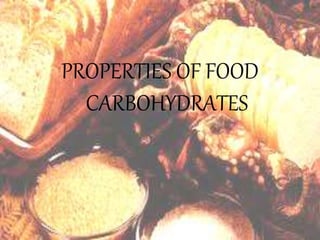
Properties of food carbohydrates
- 4. • The term carbohydrate (sugars) is derived from the french : HYDRATE DE CARBON. • They have a central role in the metabolism of animals and plants. • Sugar acts as a preservative as well as a sweetening agent, EXAMPLE: Jams, Jellies etc. • It is mainly used as a sweetening agent in beverage such as tea, coffee, fruit drinks, frozen desserts such as ice cream etc. • Confectionaries sugar is the major ingredient responsible for its shape and structure.
- 6. • The word hygroscopic means water attracting. • Sugar absorbs moisture from air, when it is exposed to air and are known to be very hygroscopic in nature, hence sugar should be stored in airtight container. • Sugar and confectionaries made from sugar tend to absorb moisture and become sticky when exposed to air.
- 7. • Sugar are soluble carbohydrates. • The solubility of mono- and oligosaccharides in water is good. • Solubility decreases as the sugars come together, as often happens in sugar powders or granulates. • The sugar arranged in descending order of solubility are- fructose, sucrose, glucose, maltose and lactose. • This property is important to obtain a particular product when mixture of sugar is used.
- 8. • The ability of sugar to dissolve and reform crystals. • Sugar is dissolved in a liquid and heated, the liquid evaporates, concentrating the sugar solution. As the solution cools, the sugar re-form into crystals. • Crystals of sugar thus obtained are very desirable in sugar coated preparations like sugar coated nuts and other such as icings and candies.
- 9. ½ thread 1 ½ thread 1 thread Soft ball
- 10. • Crystallization depends upon a number of factors include 1. Nature of the crystallizing medium, 2.Concentration of sugar in the preparation, 3.Temperature at which crystallization takes place, 4.Agitation of the sugar preparation and the addition of other ingredients such as butter, ghee, egg etc. • The greater the concentration of the sugar in the sugar preparation the faster is the rate of crystallization.
- 11. • When starch is mixed with water and heated the starch granules swell and eventually rupture, absorbing liquid which thickens the mixture. On cooling, if enough starch is used, a gel forms. • Gelatinization can take place in different temperature range, commonly it take place at 88⁰C – 90⁰C. • Common thickening agents : plain wheat flour, cornflour etc. • Two factors affect the qualities of the gel produced. These are the ratio of amylose to amylopectin and the method used to prepare the food.
- 12. •Wheat flour and cornflour = More amylose, meaning a thick but cloudy gel. • Gelatinization may be partial or complete. 1. PARTIAL GELATINIZATION (gummy): When the starch granules are dextrinized prior to being cooked in water. EXAMPLE : upma, sheera. 2. COMPLETE GELATINIZATION : complete mix of starch with water and then cooling will lead to complete gelatinization.
- 13. • Gelation is the method of solidification mainly through freezing is the creation of gel or the solidification of any gelation solution. • The gelatin is used for gelation. The gelatin liquid form a thick sugar solution and constantly thickens when freezed. There is no any definite setting point. • In some food gel is produced on cooling and in some it may be formed on heating. •Gels can either be thermo-irreversible or thermo- reversible, it all depends on the type of gelation occurred. EXAMPLE: cooling- gelation in gelatin, heating- egg white.
- 14. • Vicosity is a fluid’s resistance to flow or fluid thickness. The thicker the liquid, more is its viscosity. • The viscosity of a fluid can be measured by 1. Seeing how far a fluid can flow down an incline. 2. Viscometer- measures the force necessary to move through a liquid. 3. Household instruments- measuring how far a liquid can move on a slight incline after a certain amount of time. • Measuring of viscosity is to determine how resistant that material is to following 1. Flow down a slight incline very quickly – very little resistance to flow.
- 15. 2. Lot of force to move through a liquid, it has a lot of resistance to flow. • A fluid will be more resistant to flow the more internal friction it has. • Many food industries check for vicosity. There is an acceptable range of vicosity if it is not in the range then it will not be sold.
- 16. • Colloidal are formed when one substance is dispersed into another, but does not combine to form a solution. • There are many types of colloidal systems based on the state of two substances mixed together. GEL, SOLS, FOAM AND EMULSIONS. • Most colloidal are stable, but the two substance may separate over a period of time because of an increase in temperature or by physical force. Sometime will be unstable when frozen or heated, especially if they contain emulsion of fats and water.
- 17. • Sol and gel both are liquid loving colloids • Sol- solid particles are dispersed in liquid phase when the mixture is heated or cooled the sol changes to gel, which resembles solid rather than a liquid.
- 18. OIL+ WATER= EMULSION • Emulsion is unstable. The two liquids are immiscible. A stable emulsion is formed when two immiscible liquids are held stable by a third substance called as an Emulsifying Agent. • There are two type of emulsifying agent, HYDROPHILIC (water loving) and HYDROPHOBIC ( water hating). • Emulsion may be 1. oil-in-water(o/w) – small oil droplets in water(milk) 2. water-in-oil(w/o) – small water droplets in oil (butter)
- 19. • When small bubbles of gas dispersed in a liquid they form foaming. EXAMPLE : egg white foam, as liquid egg white is whisked, air bubbles get incorporated. • If egg white is heated, protein coagulates and moisture is driven off. This form a solid foam.